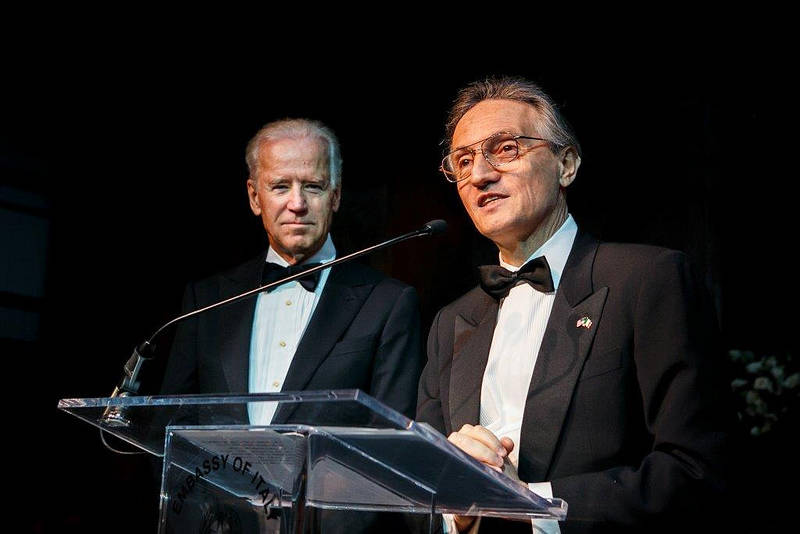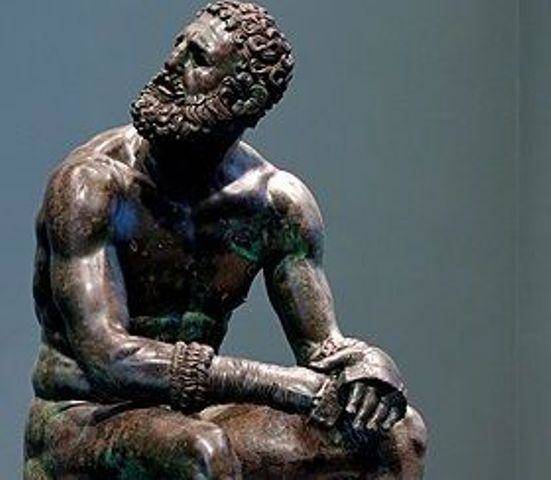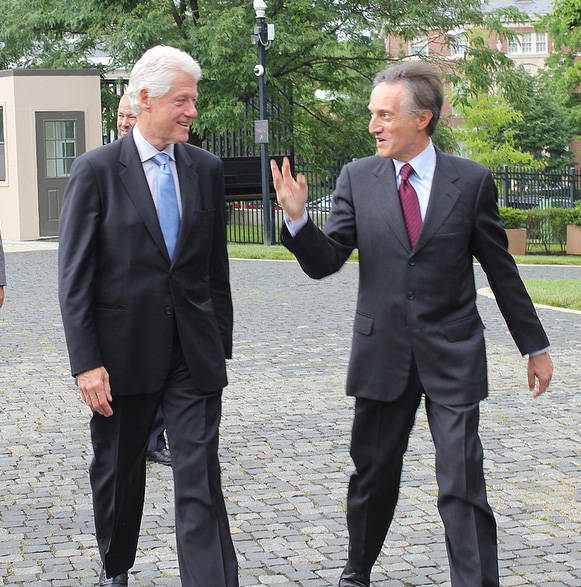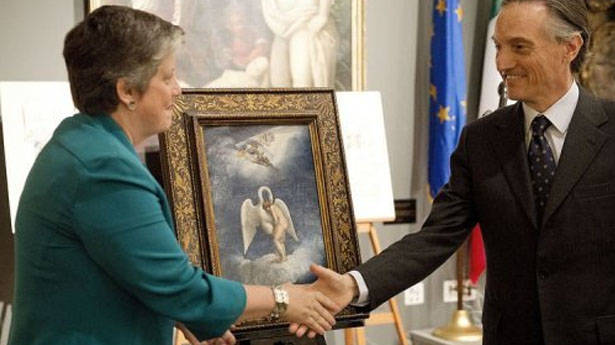Anno della Cultura. “Italy inspires US”
PER LEGGERE L'ARTICOLO IN ITALIANO >>>
What were the reasons that led to the Year of Italian Culture in the U.S.?
The main objective was to bring the best of Italy to the most important country in the world. And culture, of course, is an important part of foreign policy. With this initiative we promote Italy, but also the friendship between Italy and America.
Certainly the Year of Culture aims to promote our art, the Made in Italy label, our landscape, and our ability to create and innovate, as we did in the past and as we continue to do so today. But all of this organized around a concept. A value that the Renaissance exalted and which today is still relevant is the centrality of man. It is this dimension that, ultimately, brings us back to the universal masterpieces of music, theater, literature, and film, and the achievements of science and technology.
Whenever we get dressed to when we drive a car, sit down to eat, furnish our home, or even in the emotions we feel or the everyday objects we use, there is often a touch of Italy, of Italian beauty and originality.
Italy was, and fortunately continues to be a source of inspiration with his creativity on a human scale. “Italy inspires the U.S.” is the slogan that came to us – which also encompasses a play on words – to synthesize all of this. Without arrogance, but with legitimate pride, Italy is much more than a country: it’s a way of life.
We’re now in the second half of the Year of Culture in the United States. It’s been strongly supported by the Minister of Foreign Affairs. Can you give us an assessment?
The spirit of the Year of Culture seeks to involve the largest possible number of public and private initiatives that create a basis for building strong and lasting partnerships and increasingly broad and effective networks. In just a few short months we have put together over 200 events in more than 50 cities in the United States.
The number of companies that agreed to be sponsors was a very positive sign that, in spite of difficult economic times, Italian companies have perceived this initiative as a platform of opportunity. Up until very recently, these events were executed mainly with public resources. Now, however, the private sector contributes the lion’s share.
The response on the American side has been extraordinary. There are over 80 U.S. institutions and organizations that are involved. And that number is growing day by day, thanks to the “bottom-up” approach that we decided to adopt. The Italian Embassy, Consulates, and Cultural Institutes in the United States as well as the Minister of Foreign Affairs in Rome continually receive new input on a very wide range of subjects.
The Year of the Culture is perfect for anyone who wants to participate in this project of friendship as long as there are quality ideas. And they must be sustainable, both from an economic point of view and from the potential to generate additional initiatives actions over time. An example of this is when we try to transform one individual show into an agreement among several museums to collaborate on future exhibitions and projects.
We presented new and innovative technology to American investors and researchers, and one American university proposed developing a biotechnology campus in Italy. The competition on Boccaccio or the initiative on Machiavelli (both celebrate milestone anniversaries in 2013) are opportunities to increase the diffusion of the Italian language and the number of students who take the Advanced Placement (AP) exam in Italian.
How did Americans respond to the Year of Culture?
It was very well received by both the general public as well as those in power, from President Obama to Vice President Biden, to many the many governors and mayors I met as I toured the country. There are a few moments that stand out.
President Obama cited the Year of Italian Culture in the solemn proclamation on Columbus Day, noting that the Americans would join in celebrating the rich Italian heritage and the enduring bonds between our two countries.
Former Secretary of State Hillary Clinton hailed the Year with a joke that will remain in the annals: “I thought every year was the Year of Italian Culture!” Current Secretary of State John Kerry did likewise last February in Rome, a few days after his appointment, stating that since 1492, beginning with Columbus and Vespucci there have been “centuries of Italian and American culture,” and that “in truth, Italian culture is everywhere in our country.” It’s also received a lot of media attention of the media, with all of the major media outlets covering the Year of Italian Culture in the U.S. 2013.
The initiative went on as planned despite a difficult political situation in Italy and the ongoing economic crisis. There’s now a change of government. Will it go on as before? Will there be continuity with the new Minister?
It may seem paradoxical perhaps, but in a certain way the spirit of the Year of Culture has been reinforced by the crisis. The difficulties help us to become a team, optimizing everyone’s energy to better promote Italy and its culture.
It is a common goal that is strongly and enthusiastically supported by many public and private institutions. The support of private partners is synonymous with the quality, viability, and sustainability of cultural policies; the Minister of Foreign Affairs is committed to developing and deepening this model.
What are some of the initiatives of which you are personally proud?
Citing any one in particular would risk upsetting the ones I excluded! In general I am sincerely proud of everything we have implemented. But if I had to choose a category, I’m especially proud of those that allow us to bring to light lesser-known aspects of Italy and, in so doing, create the impetus for new projects.
I’ll give you a specific example: the celebration of the first 50 years of cooperation in space between Italy and the U.S. has allowed us to remember (how many know this?) that we were among the first countries to send a satellite into orbit. The San Marco 1 was launched on December 15, 1964 from the base of Wallops Flight in Virginia. At the same time we were able to enhance the extraordinary level of what we do today, which is a lot. A large part of the International Space Station, for example, is “Made in Italy.” And so we have created an ideal setting to sign a new agreement on cooperation in space between Italy and the United States, which will open a series of new scientific and economic opportunities.
Finally, and also to awaken the curiosity of the uninitiated, we predict that the logo of the Year of Culture will soon be brought on board the space station by an Italian astronaut.
What’s up next? Can you tell us about the upcoming event in New York City?
There are so many. For up-to-date information, visit the calendar of events at www.italyinus2013.org and our Facebook page at www.facebook.com/italyinus2013. You can also follow us on Twitter at via the hash tag #2013ItalianYear as well as the social media platform of the Italian Embassy in Washington at www.twiplomacy.it/USA.
Everyone is invited to share ideas, reactions, and information. One of the most important events of the Year will take place on June 3 at the prestigious Metropolitan Museum of Art in New York City: the opening of the exhibit “Boxer at Rest,” a famous Greek bronze statue from the second half of the fourth century BC, discovered in Rome at Quirinale in 1885 and restored at National Museum in Rome. This is a perfect example – as if one were ever needed – of how our country is a crossroads of people at the center of the Mediterranean and how the culture that has developed over time. Italian culture today is the result of a unique blend of original and different influences.
Culture remains the true wealth on which Italy can rely more than any other country. The Minister of Foreign Affairs has understood this. The Year of Culture was a demonstration of this. Don’t you think that serious programs that focus on the dissemination of culture and tourism in Italy are good step in overcoming the economic crisis?
Absolutely! Not only the Minister of Foreign Affairs, but the entire Italian system abroad is engaged in this direction. This effort produces concrete results. As for the United States, Italy is confirmed as the European destination dreamed that Americans dream of most and is one of the most visited, especially by affluent travelers.
Traveling to Italy is the setting for a most extraordinary experience. Not surprisingly, we’ve dedicated a specific section of our website (www.italyinus2013.org) to “Italy of the Territories,” which collects events, initiatives, and suggestions related to the promotion of the Italy as a particular and remarkable area. Within this section, under the title “Secret Itineraries,” every month, in collaboration with the Italian Touring Club, the Fondo Ambiente Italiano (Italian Environmental Fund), and Parchi Letterari (Literary Parks), three itineraries (one in the north, one in the center, and one in the south) are presented to promote the hidden corners of our country.
FOR MORE INFO VISIT:
(www.italyinus2013.org)










































i-Italy
Facebook
Google+
This work may not be reproduced, in whole or in part, without prior written permission.
Questo lavoro non può essere riprodotto, in tutto o in parte, senza permesso scritto.